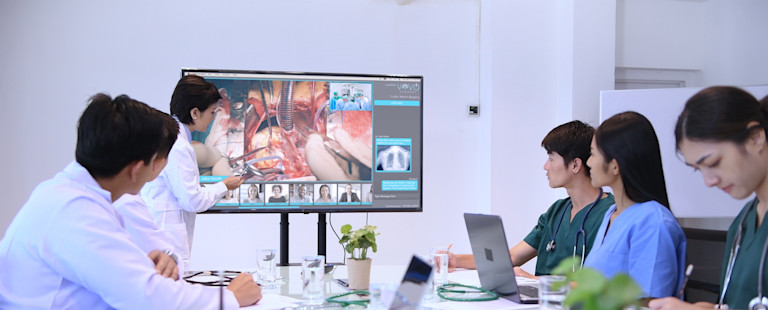AC:Incubate Spotlight: Phillip Mohabir, Co-Founder and CEO of Vivo Surgery
Vivo Surgery is redefining surgical training with a platform that unifies operating room video feeds, enables secure livestreams, and uses AI to create structured surgical datasets. As the company graduates from the Accelerator Centre and joins Creative Destruction Lab’s computational health program, co-founder and CEO Phillip Mohabir shares how they’re scaling globally, piloting in hospitals, and attracting interest from robotic surgery firms exploring semi-autonomous and autonomous procedures.

When the pandemic closed operating theatres to trainee surgeons, Dr. Aleksa Cenic, an academic neurosurgeon at McMaster University, saw an opportunity to transform how surgeons are taught and how they teach. Through his cousin, Cenic was introduced to Philip Mohabir, an experienced digital transformation leader. Together, they founded Vivo Surgery to create a secure platform that allows surgeons and medical students to observe live procedures from anywhere in the world and interact with his operating team in real time.
Since then, co-founder and CEO Phillip Mohabir and his team have gone deeper into the digital surgery stack. Vivo’s platform now unifies video feeds from multiple operating room devices into synchronized recordings, making it possible to build structured surgical datasets.
That shift has opened new doors, from helping senior surgeons train the next generation more efficiently to creating AI models that automatically segment, annotate, and generate operative notes from surgical footage.
The company’s technology is even attracting interest from robotic surgery firms exploring semi-autonomous and autonomous procedures. As Vivo Surgery graduates from the Accelerator Centre and joins Creative Destruction Lab’s computational health program in Seattle, Mohabir is focused on scaling the platform globally and building partnerships that will define the future of surgical training and digital health.
Learning from customers
As any founder knows, speaking to customers is always the best way to test whether you have product-market fit. It was during conversations with surgeons and clinicians that Mohabir and Vivo Surgery discovered they were solving another challenge for their market.
“Our recording can be used by people looking to build procedure databases. It’s one of those things that, until you start talking to enough people doing it, you don't realize that there's a problem to be solved,” he says.
The equipment setup for live streaming and recording surgical procedures is similar to that of a kitchen studio. There are multiple cameras capturing different angles, and each camera can be from a different manufacturer. Mohabir says his team quickly saw an opportunity to be the unifying platform for these disparate technologies.
“There are so many different visualization devices from different vendors in an operating room. To get that comprehensive view of the complete surgical procedure from all the devices, you have to go to individual vendors and ask for access to a tech stack. Our platform was already combining and syncing all those devices into a unified stream,” Mohabir says.
Taking training to the next level
Today, Mohabir is working to move Vivo Surgery beyond simply recording and syncing surgical procedure recordings. Vivo Surgery is using AI to create surgical models trained on recorded procedures.
“In the past you would need a surgeon to look at surgical footage and segment and annotate it. We have models that can do a first pass on that video and essentially make it structured data that can be used without needing the surgeon's time for it,” Mohabir says.
Vivo Surgery is piloting the new process in several hospitals, enabling them to build smart libraries of high-volume surgical procedures, including robot-assisted cases. The platform reduces the annotation and time burden on senior surgeons while simultaneously generating richer training assets that residents and trainees can learn from.
"Our thesis is that tools like ours will help make surgical training more scalable and standardized. The benefit here is that senior surgeons can reinvest their time into complex cases that only they can do, while hospitals still build the structured learning resources needed to train the next generation." he says.
Training isn’t the only new path for Vivo Surgery. The synced surgical recordings can also be potentially used to train AI models for autonomous and semi-autonomous surgical robots. Surgeons at John Hopkins Hospital in Baltimore recently performed an autonomous surgical procedure that was trained off of procedural videos similar to the ones captured by Vivo Surgery.
“We're getting more interest from robotic surgery companies coming to us to partner on building out their training there as they seek to make semi-autonomous and autonomous robots. We've got the methodology that takes that raw footage and turns it into a usable data set for training a robot,” Mohabir says.
Problem discovery through sales
Looking back at his time in AC:Incubate, Mohabir says insights and advice from Accelerator Centre mentors helped him set the company up for success.
“The biggest insight came when our mentors pushed us to recognize the unique assets we were accumulating. We were capturing live surgical expertise at scale. Once we understood that was our foundation, the opportunity in front of us grew much larger,” he says.
He adds that the systematic approach the AC teaches opened up new ways of thinking for his team.
“The AC’s discipline forced us to approach every conversation as discovery. It’s not just building a pipeline, but constantly testing whether what we offered solved a real pain point. That way of operating reshaped how we think about product and growth,” Mohabir says.
That customer discovery soon revealed a bigger challenge. Selling into hospitals looks very different than selling a typical SaaS product.
“In healthcare, you’re stepping into an environment with the same scrutiny and stakes as medical devices—long sales cycles, rigorous evaluation, and adoption hurdles. If we were going to inherit those kinds of obstacles, we needed to deliver more value than just telesurgery. We have to remember what we learned at the AC—sell painkillers, not vitamins,” Mohabir explains.